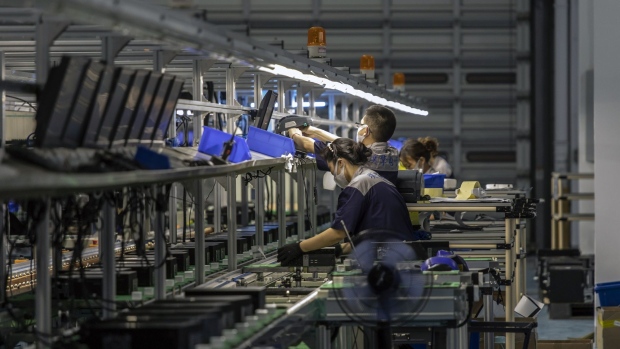Dec 8, 2022
China’s Factory-Gate Prices Remain in Deflation in November
, Bloomberg News

(Bloomberg) -- China’s factory-gate prices contracted again in November while consumer inflation eased as Covid disruptions suppressed demand, giving the central bank some room to ease policy as the economy tries to recover.
The producer price index fell 1.3% in November from a year earlier after declining by the same magnitude in October, the National Bureau of Statistics said Friday. Economists surveyed by Bloomberg had expected a 1.5% drop in prices.
Consumer inflation eased to 1.6% from 2.1% in October, in line with economists’ projections. Core inflation, which excludes volatile food and energy prices, was unchanged at 0.6%.
The data suggests “economic momentum continued to weaken,” said Zhang Zhiwei, president and chief economist at Pinpoint Asset Management. “I expect the government will do more to boost market and household confidence. The fast pace of reopening indicates the government’s sense of urgency.”
The weak figures give the People’s Bank of China some space to ease monetary policy — including a possible interest rate cut — even as the Federal Reserve and other major central banks are expected to keep hiking rates into early next year.
In a recent Bloomberg survey, economists expected the PBOC to lower the interest rate on the medium-term lending facility rate in the second and third quarters of 2023, while also lowering the one- and five-year loan prime rates by March. A cut to the reserve requirement ratio for banks could also happen.
More stimulus may also be needed as China’s path toward exiting Covid Zero remains uncertain, given a likely surge in infections that would spur more economic disruption.
The benchmark CSI 300 index gained 0.27% in the morning session, reversing earlier losses.
Record-high Covid cases in November, followed by sporadic outbreaks and movement curbs, curbed economic activity last month. Both the manufacturing and services sectors took a big hit in the month, while trade contracted at a steeper pace.
Since then, Beijing has announced several significant steps toward rolling back its strict Covid Zero policy and the government has signaled a focus on boosting economic growth next year.
Bruce Pang, chief economist and head of research for Greater China at Jones Lang LaSalle Inc., said inflationary pressures may rise as Covid Zero ends.
“China’s potential reopening could bring inflationary challenges, considering a surge in demand, especially the accelerating household consumption, and short-term disruption to labor supply, production and supply chains amid an inevitable exit wave of new cases,” he said.
Producer prices slipped into deflation in October for the first time in nearly two years as global growth softened and commodity costs continued to slide. The drop in November was due to a high base of comparison with last year, according to a statement from Dong Lijuan, chief statistician at the NBS. PPI skyrocketed in 2021 on soaring commodity prices.
What Bloomberg Economics Says ...
“China’s steady PPI reading in November — relative to expectations for a decline deeper into deflation — suggests price pressures are letting up a little. Even so, broad CPI disinflation remains the trend. The bigger picture is that reopening should start to buoy demand, supporting prices in the coming months. That won’t get in the way of a rate cut in 1Q23 — the People’s Bank of China will have room to ease and the motivation: the economy needs the support.”
— David Qu, economist
Read the full report here.
Price declines in chemical raw materials, along with chemical product and fiber manufacturing all widened in November.
Consumer prices, meanwhile, have been kept in check by Covid disruptions that have depressed movement and spending — a contrast to major developed nations that are battling persistently high inflation. Dong attributed November’s easing in part to the continued virus outbreaks.
In the CPI basket, transportation prices dropped 2% from a year earlier, while rent prices slid 0.7%.
Economists expect China’s gross domestic product may expand around 3% this year, far lower than a government target given in the spring of about 5.5%.
--With assistance from April Ma.
(Updates with additional details.)
©2022 Bloomberg L.P.






